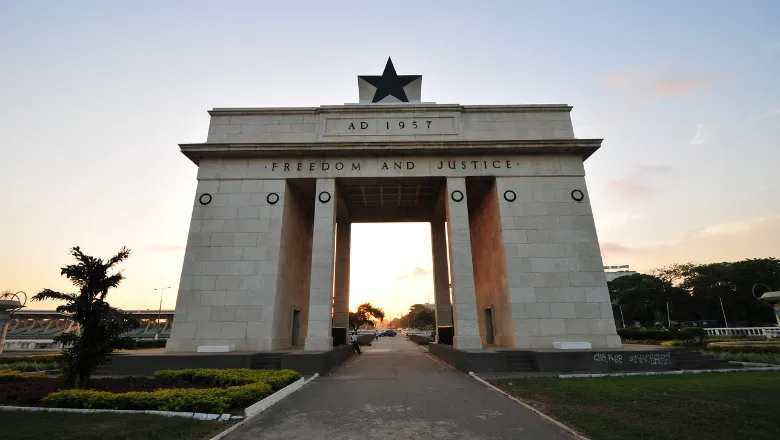01 August 2024
COMMENT: Ghana elections - ethnicity is not allowed in the country's politics, yet it still helps shape outcomes
By Dr Clement Sefa-Nyarko, Lecturer in Security, Development and Leadership in Africa
Dr Clement Sefa-Nyarko explains why ethnicity continues to influence politics in Ghana.

Ghana, which has more than 70 ethnic groups, has been among the most stable democracies in Africa since 1992. It has achieved this by outlawing the use of ethnicity in party politics. The 1992 constitution bars the explicit use of social identities in party politics. That includes ethnic group names, symbols, colours, or artefacts. Yet, Ghanaian politics is not completely devoid of ethnicity. Political scientist Clement Sefa-Nyarko explains why this matters as Ghana prepares for another election in December.
Why did Ghana need a clause in its 1992 constitution designed to squeeze ethnicity out of electoral politics?
Ethnicity has had a disruptive effect on Ghana since colonial times. The British used ethnicity to advance their indirect rule policy. Kwame Nkrumah, the country’s first postcolonial leader, inherited this and struggled with the predominantly Asante National Liberation Movement over whether newly independent Ghana should be a federal or unitary state. A federal state would have given more autonomy to dominant chieftaincies and ethnic groups like the Asantes. Nkrumah didn’t want this. The unitary model won.
However, the development of the unitary state was complicated by vulnerabilities associated with multiple social identities and socioeconomic decay. Ghana’s five coup d’états since 1966 were all mediated by some degree of ethnic grievances. Ghana has nine major ethnic groups. The biggest are Akans, inclusive of Asantes (47.5%), Mole-Dagbanli (16.6%), and Ewe (13.9%). There is religious diversity too. Christians form two-thirds of the total population. There are also Muslims (17.6%), those who identify as non-religious (5.2%) and traditionalists (5.2%).
Successive governments, both democratic and military, have taken steps to curb the crisis of ethnicity in public life. For instance, Nkrumah dissolved ethnic and regional political parties through the Avoidance of Discrimination Act in 1956. The country’s military leader from 1972 to 1978, Ignatius Kutu Acheampong, banned ethnic symbols or expressions from official documents. The 1992 constitution, currently in use, followed suit.
The de-ethnicisation of party politics in 1992 was accompanied by the removal of party politics and ethnicity from the local government level. This meant that officials were elected to administer cities and local authorities without considerations of political party affiliation. I recently analysed this innovation and its significance for political stability.
How has that worked out based on your research in the Ashanti and Volta regions?
My findings confirm that ethnicity has widely been tamed in Ghanaian politics.
Fourteen of the country’s 16 regions have narrower margins of voting or have swing constituencies. The Ashanti and Volta regions are the exceptions. They comprise about a quarter of the voting population; 76.4% and 71.7% of residents in the Ashanti and Volta regions are Asantes and Ewes respectively. Since 1992, the Asantes have voted consistently for the New Patriotic Party. Ewes, meanwhile, have voted for the National Democratic Congress. These two parties have won every election since the country returned to democratic rule.
I interrogated several possible explanations for this ethnic voting pattern. These include the backgrounds of party candidates, ownership of political parties and allocation of resources to strongholds. I also checked tensions between in-group and national identity (citizenship). And I assessed prejudices among the Asantes and Ewes.
None, by itself, offers an adequate explanation.
What do you conclude from your findings?
Ethnicity still influences electoral outcomes in Ghana. However, this happens on a limited scale and is to be expected in a multi-ethnic society. In silencing ethnic voices in party politics, the 1992 constitution introduced several alternative avenues for multi-ethnic self-expression. These include establishing locally led local government authorities and leaving customary land governance to chiefs and families.
These avenues provide options for local (and ethnically homogeneous) communities to make decisions on their development. They can also participate in local politics without explicitly referencing party politics.
The effect is that, while there are some elements of ethnicity in party politics, most Ghanaians do not see national elections as a zero sum game. Local assembly elections are also peaceful compared to national, party-driven elections.
What’s the significance of your findings for the upcoming elections?
Together with other socioeconomic factors, ethnicity will continue to influence party politics in Ghana. This includes the upcoming December elections. However, this will not have security implications like ethnic based clashes for the country’s democracy.
Support for the New Patriotic Party and the National Democratic Congress in the Asante and Volta regions is unlikely to change. This is despite the exit of a prominent Asante politician, Alan Kyerematen, from the governing New Patriotic Party to form a new political party after he lost to the vice-president, Mahamadu Bawumia, in the primaries. It is instructive to note that the two major parties are led by candidates from Mole-Dagbanli backgrounds.
The ethnic background of politicians has not mattered much in determining electoral outcomes in Ghana, and that is unlikely to change.
Beyond the Ashanti and Volta regions, support for the two main political parties over the last few decades have been widely influenced by factors such as the socio-economic conditions of urban populations and party campaign promises. Recent economic policies of the ruling government, such as its debt exchange programme and the banking crisis that hit the urban middle class the most, will likely have more of an impact on the urban population’s voting decisions.
This article is republished from The Conversation under a Creative Commons license. Read the original article



